
by Mary | Dec 21, 2015 | Design News
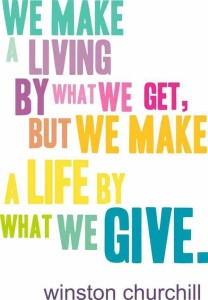 r.o.i. Design has been blessed with more than 20 years of business and 100’s of customers. But sometimes at the end of the year, we wish we had more. More so we could give to all the non-profits we have worked for, supported and otherwise respected over the years.
r.o.i. Design has been blessed with more than 20 years of business and 100’s of customers. But sometimes at the end of the year, we wish we had more. More so we could give to all the non-profits we have worked for, supported and otherwise respected over the years.
Our heartfelt greeting goes out to all these groups and hoping that in some small way our voice of support will make a difference and influence others to seek you out, learn how you love, and give the best gifts they can.
This year especially on our hearts is a project that our associate Ken Watkins of Architectural Concepts has been working on since 2012.
The name of the organization is Zoe Waters. Their website is www.zoewaters.org, and they also have a Facebook page with the same name. They started in Kenya, but are currently active with projects in northern Kenya, Tanzania, and India.
The idea for Zoe Waters came about as the result of a short-term mission trip to Northern Kenya sponsored by Cornerstone Church (Caledonia, Michigan) in 2011. This team was not only able to witness first-hand the very real needs in this area of the world (both spiritual and physical), but also to start to meet some of these needs with the “Zoe Waters” methodology. This methodology included the pairing of the audio gospel distribution with the provision of a village water well, all in conjunction with local pastors and missionaries who can continue to provide spiritual support to these previously unreached tribes.
Other groups in alphabetical order:
Colossian Forum– www.colossianforum.org
Crossroads Church– www.crossroadswesleyan.org
Grand Rapids Child Discovery Center– www.grcdc.org
Goodwill Industries of West Michigan – www.goodwillwm.org
Health Intervention Services- www.hisgr.org
Kala Project– www.kalaproject.org
Kids Hope– www.kidshopeusa.org
Kentwood Community Church– www.kentwoodcommunitychurch.com
Lifestream– www.lifestreamweb.org
Springhill Camp – www.springhillcamps.com
Theological Book Network– www.theologicalbooknetwork.org

zoewaters.org
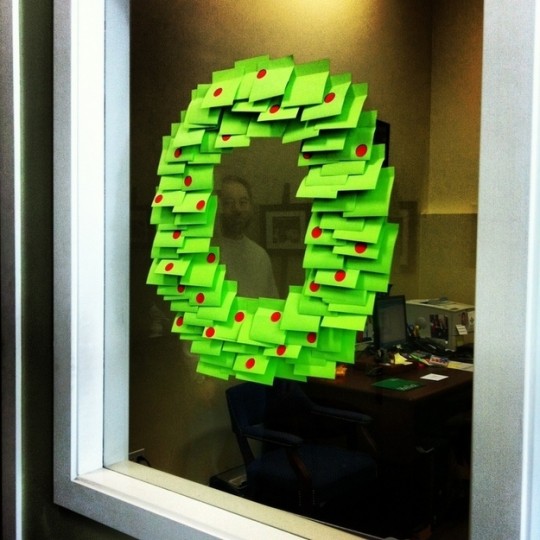
by Mary | Dec 20, 2015 | Design News, Interior Design
The holidays bring out the best (and sometimes the worst) of the season.
r.o.i. Design would like to share with you some of our “Do’s and Don’ts of Decorating Tips” for the work place.
Do’s:

Post-em Note Wreath from SWG Law
- Make your decorations fit your brand. Use the holiday to tell folks about who you are as a company.
- Bring in live plants and foliage!
- Decorate with holiday lights, within reason!
- Show the spirit of the season for a couple of weeks (unless you are a retail store, of course, where you have to sport decorations for six weeks!)
Don’ts:
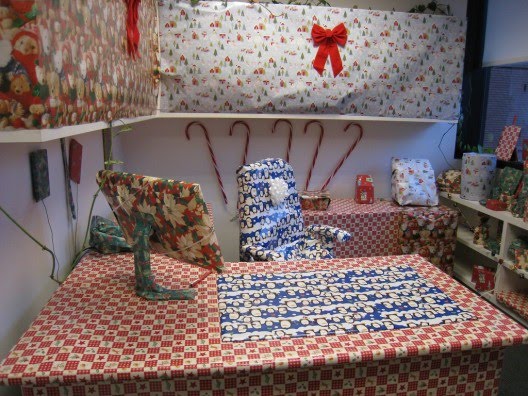
Anyone seen the scotch tape dispenser?
- Wrap anything but gifts with wrapping paper!
- Feature creepy dolls and animals.
- Create a clutter that keeps work from happening.
- Display anything that might alienate an employee or a customer.
Designing for the holidays is a great way to share with others your particular tastes and views. Have fun and enjoy the season!

by Mary | Dec 6, 2015 | Design News, Hospitality Design, Project Management
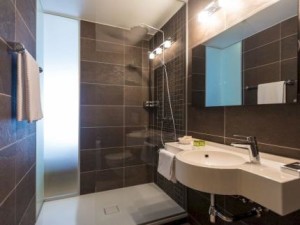
Remodeled Bathroom (Image from laterooms.com)
It isn’t easy to be cool. And hospitality design is a cutting edge market. A national hotel brand knows design and technology are key factors in property improvement plans.
Properties that want to maintain their status with a national hotel brand undergo regular inspections to make sure their property meets the standards of the brand. During the recession a few years ago, there was some leniency in compliance, but since 2011 national brands are less likely to look the other way. There has been a conscious attrition of properties by the savvy big names who know that they have to compete in each market by scrutinizing and discerning customers.
Today’s customers are technically plugged-in. They are informed and that doesn’t give a hotel property much wiggle room when it comes to meeting expectations. National brand websites promote an experience that needs to be delivered whether in Anchorage or Miami.
Hotels that want to establish a relationship with a national hotel brand have a rigorous review. Existing hotels that haven’t updated their properties in the last 3-5 years are being challenged by the costs related to required updates.
The areas that challenge the existing property and could be higher priorities on a PIP (Property Improvement Plan) include:
Technology
- From registration to check in, in-room stay and checkout, the customer expects to control their experience through their online capabilities.
- In-room TV’s are monitors with streaming TV, and customer access to their business and personal sites needs to be immediate.
In-room services
- Customers want the ability to make their home for a night meet their needs. Whether that means writing a business report, taking along a pet, eating in, exercising in or conducting a virtual business meeting.
Interior design
- If properties haven’t updated since 2011, they are faced with changes in customer expectations in lighting, bedding, finishes and furnishings (in that order).
Property services
- Not that long ago the pool and fitness center was a “must have”, and while still preferred for general business and personal accommodations, it is out-ranked by giving the guest enough room in their room to be able to exercise. Resort hotels still need fitness centers, pools and spas.
- While today’s guest doesn’t need a real front desk, they do need at least the ability to find a small meal, a beverage, the equivalent of a local concierge or “helper”.
Hotel developers who are building today, find the requirements by a national hotel brand to be both more specific and strict, but also more consultative. Brands are very eager to have strategically placed and built properties and those requirements come with costs, so most hotel companies want to appear to be and in most cases, be helpful.
r.o.i. Design is seeing an emerging trend in national hotel brands that further separates those properties from the boutique hotels and the resort hotels. The boutique and resort hotels are able to provide unique style and services based on a developer or regional preference. Customers are discerning and are deciding if their stay requires a national brand, a boutique hotel or a resort experience.
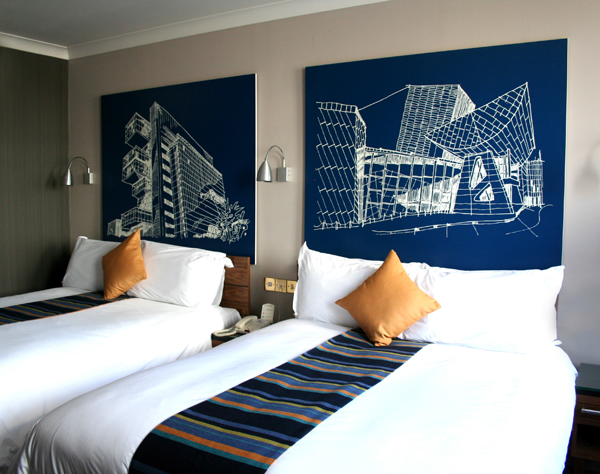
by Mary | Dec 6, 2015 | Design News, Graphic Design, Hospitality Design
Today, wall art and décor in interior design is significant; it has the interest of the guest and is taking a larger portion of the remodeling and new construction budget.

Corridor Photo from HotelArts. CA
This trend in part is based on the emerging custom wall paper and specialty graphics category that is merging wall finishes with wall art. Technology has made custom printing and custom manufacturing fueling creativity in hospitality interior design.
Wall art is seen in public areas but also in corridors, sleeping areas, and vanity areas. It can be also seen on advertising, marketing and TV’s within the guest suites.
What is considered viable wall art now?
Guests accept items hung on the wall or covering the wall to be viable “décor” when
- The subject matter reflects the local area in content or creator
- It is graphic design reflecting either property brand or current trends
- The “art” is recognizable as current style in trend based on their own experience of media and current events
- The technology or method of producing is current and of interest (i.e. custom wall paper or oversized graphics)
How does an owner create a wall art program?
- Most interior design firms now provide art selection and art design services.
- Local graphic designers and art galleries are prepared to offer custom programs.

Image from The Guardian Pe. CA
What is the ROI of a wall art program?
A wall art program can promote and connect with regional organizations in either content or reference. This connection exposes the property to a non-user audience, promoting future business.
A wall art program can be copyrighted and be considered an asset of the property, being used in marketing, advertising and social media. Reprints can become “products for sale” through the property’s channels.
When a hospitality property can further describe their brand through visuals, that can also be considered “art”, it creates emotional and lasting impressions with their customers.
Wall art in hospitality is one of many ways properties are trying to be personal, expressing their values and interests. Art makes personal connections, a valuable asset in building customer loyalty.
Updating an interior by changing wall art and décor is far less disruptive than changing an architectural finish. It allows owners to “update” without upsetting room rentals.

by Mary | Dec 6, 2015 | Design News, Hospitality Design
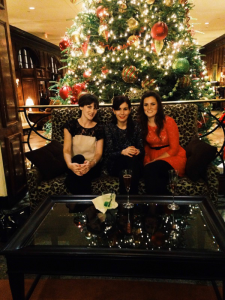 Hospitality properties have guests who spend the holidays with them; sometimes by choice and sometimes not, sometimes in small groups and sometimes not. It is a time for properties to show what they are made of and fill in the gaps for holiday guests.
Hospitality properties have guests who spend the holidays with them; sometimes by choice and sometimes not, sometimes in small groups and sometimes not. It is a time for properties to show what they are made of and fill in the gaps for holiday guests.
During the winter holiday, staff is called on to be even more personal and intentional. These holidays show how well a properties staff is hired, trained and managed to support an experience that is worthy to be considered a celebratory time. A time when emotional connections can be made.
Guests who decide to celebrate the season with you want the property to give them the holiday they couldn’t have at their own home. Decorations, uniforms, sentiment, menu items, activities, the works!
It may be less important to recreate their particular traditions than it is have a hotel tradition. Properties and resorts who create a branded event and all the anticipation building up to it, have set the stage to a wonderful memory. But an event alone won’t be enough.
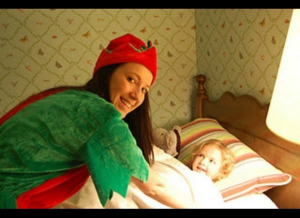
Elf – Style Sleep Tight Goodnight
- It may be guests with little to no family decide to celebrate with you. That means the staff has to make a personal connection with guests, recreating family and intimacy.
- It may be guests who are taking the whole family to your site expect you to recreate “home”. This group needs greater flexibility in food service, identified hosts and personalities that can help them through their reunions.
- It all cases guests are ready to be surprised by joy, generosity and the ability to share.

Holiday Surprises for Customers of WestJet
An example of the type of success that can be had is described by blogger Alexander Kellerman who wished this celebration happened in a hotel verses in an airport-http://www.hotelierinc.com/is-the-hotel-industry-losing-its-hospitality/#more-1340
There is no bluffing during the holidays. The guests have high expectations and vulnerabilities. Meet those needs and you have a guest forever.

 r.o.i. Design has been blessed with more than 20 years of business and 100’s of customers. But sometimes at the end of the year, we wish we had more. More so we could give to all the non-profits we have worked for, supported and otherwise respected over the years.
r.o.i. Design has been blessed with more than 20 years of business and 100’s of customers. But sometimes at the end of the year, we wish we had more. More so we could give to all the non-profits we have worked for, supported and otherwise respected over the years.











